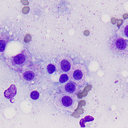Tumour necrosis factor-related apoptosis-inducing ligand induces apoptosis in canine hemangiosarcoma cells in vitro.
Kata kunci
Abstrak
Tumour necrosis factor-related apoptosis-inducing ligand (TRAIL) is an apoptosis-inducing cytokine that shows potential therapeutic value for human neoplasms, and is effective in some canine tumours; however, its potential for killing canine hemangiosarcoma (HSA) cells is unknown. Thus, we evaluated the proapoptotic effect of TRAIL in nine canine HSA cell lines. Cells (JuA1, JuB2, JuB2-1, JuB4, Re11, Re12, Re21, Ud2 and Ud6) were cultured with three recombinant human TRAILs (rhTRAILs): TRAIL-TEC derived from Escherichia coli, TRAIL-TL derived from mammalian cells and isoleucine zipper recombinant human TRAIL (izTRAIL) containing an isoleucine-zippered structure that facilitates trimerization. TRAIL-TEC did not decrease the cell viability in any of the cell lines tested, whereas the other two rhTRAILs effectively decreased the viability of all cell lines as assessed by the WST-1 assay. In canine HSA cells, izTRAIL induced apoptosis more effectively than TRAIL-TL. In JuB4, Re12, and Ud6 cells, izTRAIL increased the activation of caspase-3 and caspase-8 and caused poly (ADP-ribose) polymerase degradation. Moreover, izTRAIL treatment increased the proportion of Annexin V+/ Propidium iodide (PI)- apoptotic cells and nuclear fragmentation in izTRAIL-sensitive cells. These results show that rhTRAIL can induce apoptosis in canine HSA cells, but the sensitivity of TRAIL was different depending on the cell lines. Therefore, TRAIL could be an effective therapeutic agent against canine HSA, but the specific mechanism of resistance should be determined to clarify under what conditions this treatment would be most effective.


